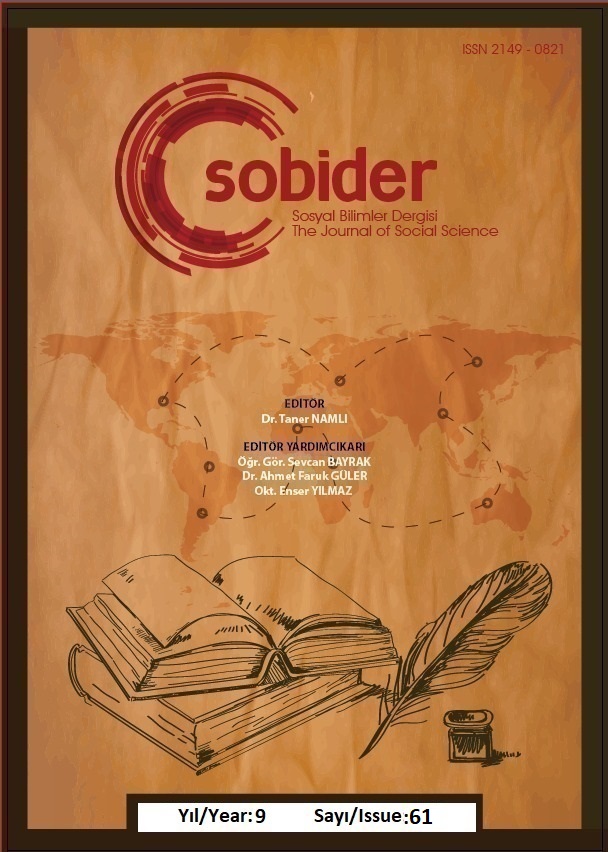Author :
Abstract
- yüzyıl, sanat pratiklerinin değiştiği, birbirine kaynaştığı, eleştiri ve diyalektiğe açık olarak, köklü değişimlerin gerçekleştiği bir süreç olmuştur. Bu süreçte heykel sanatının da temel kodlarında büyük değişimler olmuş ve heykel; biçim, teknik, malzeme ve uygulama konusunda yenilikçi birçok yaklaşımı bünyesinde toplayarak anlamını genişletmiştir. 20.yüzyıl ortalarına gelindiğinde ABD’nin sanat merkezi New York’ta radikal bir akım olarak Minimalizm ortaya çıkmıştır. Aynı tarihlerde ülkenin batı yakası olan Kaliforniya eyaletinde de minimalist çalışmalara benzer ama farklı yenilikleri barındıran heykeller yapılmaya başlanmıştır. Betimsel tarama modeliyle oluşturulan bu çalışmanın amacı, 1960’larda ABD’nin batı yakasında ortaya çıkan “Işık ve Uzay Sanat Hareketi”ni 20.yüzyıl sanatı içerisinde konumlandırmak ve heykel sanatına kattığı yenilikçi yaklaşım ile uygulama yöntemlerini; malzeme, teknik ve biçim bağlamında incelemektir. Oluşum süreci içerisinde ele alınan bu sanatsal hareket çerçevesinde hedeflenen, sanatçıların benimsedikleri yenilikçi malzeme ve tekniklere odaklanarak, onların uğraşlarının doğasını karakterize etmek ve heykelin dönüşüm sürecinde nasıl bir etkilerinin olduğunun anlaşılmasını sağlamaktır.
Keywords
Abstract
The 20th century has been a process in which art practices have changed, merged with each other and radical changes have taken place, open to criticism and dialectics. In this process, there were great changes in the basic codes of the art of sculpture and sculpture has expanded its meaning by incorporating many innovative approaches in form, technique, material and application. By the mid-20th century, Minimalism emerged as a radical movement in New York, the art center of the USA. At the same time, sculptures similar to minimalist works but with different innovations began to be made in the state of California, which is the west side of the country. The aim of this study, which was created with the descriptive scanning model, is to position the "Light and Space Art Movement" that emerged in the west coast of the USA in the 1960s within the 20th century art and to investigate the innovative approaches and application methods it added to the art of sculpture; material, technique and form. Within the framework of this artistic movement, which is considered in the formation process, the aim is to characterize the nature of the artists' efforts by focusing on the innovative materials and techniques adopted by the artists and to provide an understanding of what effects the sculpture has in the transformation process.
Keywords
- Adcock, Craig E. Turrell, J. (1990). James Turrell: The Art of Light and Space. Berkeley, Los Angeles and Oxford: University of California Press.
- Antmen, A. (2008). 20. Yüzyıl batı sanatında akımlar. EA Publish.
- Ateşli, E. (2017). Günümüz heykel sanatında geleneksel malzeme ve yeni arayışlar (Yüksek Lisans Sanat Çalışması Raporu), Hacettepe Üniversitesi, Heykel Anasanat Dalı, Ankara.
- Butterfield, J. (1993). The art of light + space. New York: Abbeville Press.
- Clark, Robin. 2011. Phenomenal California Light, Space, Surface. Los Angeles: University of California Press.
- De Duve, T. (2002). Ex situ*. (Çev: Kemal Atakay), Sanat Dünyamız, (82), 101–121.
- Demirkol, C. V. (2008). “Batı sanatında modernizm ve postmodernizm”. Evrensel Basım Yayın.
- Eczacıbaşı Sanat Ansiklopedisi. (1998). 2. Cilt. İstanbul: Yem Yayın
- Erinç, S. M. (1993). Amerika’da heykel sanatı.
- Foster, H. (2013). Sanat-mimarlık kompleksi: küreselleşme çağında sanat, mimarlık ve tasarımın birliği. (Çev: S. Özaloğlu). İstanbul: İletişim Yayınları.
- Germaner, S. (1997). 1960 Sonrası sanat; akımlar, eğilimler, gruplar, sanatçılar. İstanbul: Kabalcı Yayınevi.
- Hiçyılmaz, G. (2018). Heykel sanatında değişen malzeme tutumları bağlamında 1960 sonrası heykelde yumuşak malzemelerin ortaya koyduğu yeni olanaklar (Yüksek Lisans Tezi). Anadolu Üniversitesi, Heykel Ana Sanat Dalı, Eskişehir.
- Karacan, N. (2013). Tarihsel süreç içinde heykel formu. Sanat ve Tasarım Dergisi, 4(4), 17-32.
- Katzberg, L.M. (2009). Cultures of light: contemporary trends in museum exhibition. (Doktora Tezi). Amsterdam: University of Amsterdam, Amsterdam School for Cultural Analysis.
- Koçay, T. (2021). 20. Yüzyıl heykelinde görsel ve estetik bir öge olarak yapay ışık (Sanatta Yeterlik Tezi), Anadolu Üniversitesi, Heykel Ana Sanat Dalı, Eskişehir.
- McWilliams, C. (1973). Southern California: An island on the land. Gibbs Smith.
- Jovanovich-Kelley, M. (2012). PHENOMENAL: California Light, Space, Surface, by Robin Clark. Southern California Quarterly, 94(1), 144–147. https://doi.org/10.1525/scq.2012.94.1.144 Erişim tarihi: 20.08.2020
- O’Doherty, B. (2013). Beyaz Küpün İçinde* Galeri Mekanının İdeolojisi. (Çev. A. Antmen). İstanbul: Sel Yayıncılık
- Poissant, Louise, ed. “New Media Dictionary”. (2003). Leonardo, 36(1), 71–76. http://www.jstor.org/stable/1577286 Erişim Tarihi: 16.02.2020
- Rivenc, R. (2016). Made in Los Angeles: materials, processes, and the birth of West Coast minimalism. Getty Publications.
- Rivenc, R., Learner, T., & Richardson, E. (2012). The LA look from start to finish: materials, processes and conservation of works by the finish fetish artists. In Postprints ICOM-CC 16th Triennial Conference. ICOM.
- Rocha AM, Almeida T, Machado G. The Threshold between the Material and Immaterial Light. Notes on Luminescence and Dark Environments. Arts. 2021; 10(3):56. https://doi.org/10.3390/arts10030056 Erişim Tarihi: 08.12.2021
- Turani, A. (2013). Dünya sanat tarihi. (17.baskı). İstanbul: Remzi Kitabevi.
- Turrell, J., & Haskell, B. (1980). James Turrell, Light & Space: An Exhibition [October 22, 1980-January 1, 1981. Whitney Museum of American Art.
- Weller, R. A. (2008). Los Angeles look (ing): Process, perception, and popular culture in the art of Larry Bell, Craig Kauffman, and John McCracken. University of Delaware.
- Yılmaz, M. (2013). Modernden postmoderne sanat. (2.baskı). Ankara: Ütopya Yayınevi
- http7. https://artmap.com/davidzwirner/exhibition/john-mccracken-2010
- Görsel 1. http://www.johannesreponen.com/reference-journal/2019/7/19/proun-room- prounenraum-1923-by-el-lissitzky
- Görsel 3. https://franklinparrasch.com/exhibitions/2004_11_craig-kauffman/images/#2
- Görsel 6. https://ocula.com/art-galleries/david-zwirner/exhibitions/works-from-the-1960s- and-1970s/
- Görsel 7. https://ocula.com/art-galleries/david-zwirner/exhibitions/works-from-the-1960s-
- Görsel 8. https://www.wikiart.org/en/helen-pashgian/untitled-1970-1
- Görsel 10. https://www.nytimes.com/2011/04/11/arts/design/john-mccracken-sculptor-of- geometric-forms-dies-at-76.html





